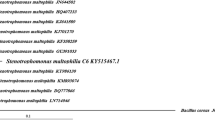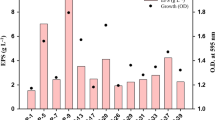Abstract
The bacterial strains that are able to produce biopolymers that are applied in industrial sectors present a source of renewable resources. Some microorganisms are already applied at several industrial sectors, but the prospecting of new microbes must bring microorganisms that are feasible to produce interesting biopolymers more efficiently and in cheaper conditions. Among the biopolymers applied industrially, polyhydroxybutyrate (PHB) and exopolysaccharides (EPS) stand out because of its applications, mainly in biodegradable plastic production and in food industry, respectively. In this context, the capacity of bacteria isolated from pigeonpea root nodules to produce EPS and PHB was evaluated, as well as the cultural characterization of these isolates. Among the 38 isolates evaluated, the majority presented fast growth and ability to acidify the culture media. Regarding the biopolymer production, five isolates produced more than 10 mg PHB per liter of culture medium. Six EPS producing bacteria achieved more than 200 mg EPS per liter of culture medium. Evaluating different carbon sources, the PHB productivity of the isolate 24.6b reached 69% of cell dry weight when cultured with starch as sole carbon source, and the isolate 8.1c synthesized 53% PHB in dry cell biomass and more than 1.3 g L−1 of EPS when grown using xylose as sole carbon source.



Similar content being viewed by others
References
Sutherland, I. W. (1998). Trends in Biotechnology, 16, 41–46.
Kumar, A. S., Mody, K., & Jha, B. (2007). Journal of Basic Microbiology, 47, 103–117.
Skorupska, A., Janczarek, M., Marczak, M., Mazur, A., & Krol, J. (2006). Microbial Cell Factories 5, n.p.
Wang, P., Zhong, Z. T., Zhou, J., Cai, T., & Zhu, J. (2008). Archives of Microbiology, 189, 525–530.
Mendonça, R. H., Thire, R., Costa, M. F., & Filho, F. C. S. (2009). Polimeros, 19, 143–148.
Madison, L. L., & Huisman, G. W. (1999). Microbiology and Molecular Biology, 63, 21–53.
Silva, L. F., Goméz, J. G. C., Rocha, R. C. S., Taciro, M. K., & Pradella, J. G. D. (2007). Quimica Nova, 30, 1732–1743.
Trainer, M. A., & Charles, T. C. (2006). Applied Microbiology and Biotechnology, 71, 377–386.
Fernandes Júnior, P. I., Rohr, T. G., Oliveira, P. J., Xavier, G. R., & Rumjanek, N. G. (2009). Pesquisa Agropecuária Brasileira, 44, 1184–1190.
Rottava, I., Batesini, G., Silva, M. F., Lerin, L., Oliveira, D., Padilha, F. F., et al. (2009). Carbohydrate Polymers, 77, 65–71.
Castellane, T. C. L., & Lemos, E. G. M. (2007). Pesquisa Agropecuária Brasileira, 42, 1503–1506.
Vincent, J. M. (1970). A manual for practical study of root nodule bacteria, IBP Handbook. Oxford: Blackwell Scientific Publications.
Xavier, G. R., Martins, L. M. V., Neves, M. C. P., & Rumjanek, N. G. (1998). Biology and Fertility Soils, 27, 386–392.
Teixeira, F. C. P., Borges, W. L., Xavier, G. R., & Rumjanek, N. G. (2010). Brazilian Journal of Microbiology, 41, 201–208.
Hammer, Ø., Harper, D. A. T., & Ryan, P. D. (2001). Palaeontologia Electronica 4, n.p.
Kumari, B. S., Ram, M. R., & Mallayah, K. V. (2008). African Journal of Microbiology Research, 3, 10–14.
Pimenta, F. D., Lopes, L. M. A., & França, F. P. (2008). Applied Biochemistry and Biotechnology, 150, 33–49.
Karr, D. B., Waters, J. K., & Emerich, D. W. (1983). Applied and Environmental Microbiology, 46, 1339–1344.
Conover, W. J. (1971). Practical nonpametric statistics. New York: John Wiley and sons Inc.
Leite, J., Seido, S. L., Passos, S. R., Xavier, G. R., Rumjanek, N. G., & Martins, L. M. V. (2009). Revista Brasileira de Ciência do Solo, 33, 1215–1226.
Bushby, H. V. A., & Marshall, K. C. (1977). Soil Biology and Biochemistry, 9, 143–147.
Batista, J. S. S., Hungria, M., Barcellos, F. G., Ferreira, M. C., & Mendes, I. C. (2007). Microbial Ecology, 53, 270–284.
Lima, A. A. (2008). M.S.c. Dissertation, Universidade Federal Rural do Rio de Janeiro, Seropédica, Brazil.
Fernandes Júnior, P. I. (2009). Ph.D. Thesis, Universidade Federal Rural do Rio de Janeiro, Seropédica, Brazil.
Quagliano, J. C., & Miyazaki, S. S. (1999). Applied Biochemistry and Biotechnology, 82, 199–208.
Mercan, N., Aslım, B., Yüksekdağ, Z. N., & Beyatlı, Y. (2002). Turkish Journal of Biology, 26, 215–219.
Rinaudi, L. V., & Giordano, W. (2010). FEMS Microbiology Letters, 304, 1–11.
Kim, B. S. (2000). Enzyme Microb Technol, 27, 774–777.
Ramadas, N. V., Singh, S. K., Soccol, C. R., & Pandey, A. (2009). Brazilian Archives of Biology and Technology, 52, 17–23.
Cavalheiro, J. A. M., Grandfils, C., & Fonseca, M. M. R. (2009). Process Biochemistry, 44, 509–515.
Ben Rebah, F., Prevost, D., Tyagi, R. D., & Belbahri, L. (2009). Applied Biochemistry and Biotechnology, 158, 155–163.
Reddy, S. V., Thirumala, M., Reddy, T. V. K., & Mahmood, S. K. (2008). World Journal of Microbiology and Biotechnology, 24, 2949–2955.
Halami, P. M. (2008). World Journal of Microbiology and Biotechnology, 24, 805–812.
Haas, R., Jin, B., & Zepf, T. F. (2008). Bioscience, Biotechnology, and Biochemistry, 72, 253.
Martinez-Toledo, M. V., Gonzalez-Lopez, J., Rodelas, B., Pozo, C., & Salmeron, V. J. (1995). Journal of Applied Bacteriology, 78, 413.
Lopes, M. S. G., Rocha, R. C. S., Zanotto, S. P., Goméz, J. G. C., & Silva, L. F. (2009). World Journal of Microbiology and Biotechnology, 25, 1751–1756.
Arora, N. K., Singhal, V., & Maheshwari, D. K. (2006). World Journal of Microbiology and Biotechnology, 22, 603–606.
Ratcliff, W. C., Kadam, S. V., & Denison, R. F. (2008). FEMS Microbiology Ecology, 65, 391–399.
Helm, J., Wendlandt, K. D., Jechorek, M., & Stottmeister, U. (2008). Journal of Applied Microbiology, 105, 1054–1061.
Kuçuk, C., & Kivanc, M. (2009). Annales de Microbiologie, 59, 141–144.
Arun, A., Murrugappan, R., Ravindran, A. D. D., Veeramanikandan, V., & Balaji, S. (2006). African Journal of Biotechnology, 5, 1524–1527.
Wang, J., & Yu, H. Q. (2007). Applied Microbiology and Biotechnology, 75, 871–878.
Tavernier, P., Portais, J. C., Saucedo, J. E. N., Courtois, J., Courtois, B., & Barbotin, J. N. (1997). Applied and Environmental Microbiology, 63, 21–26.
Acknowledgements
The authors thanks Coordenação de Aperfeiçoamento de Pessoal de Nível Superior (CAPES), Conselho Nacional de Desenvolvimento Científico e Tecnológico (CNPq), Embrapa Agrobiologia, and Curso de Pós-graduação em Agronomia-Ciência do Solo (CPGA-CS) of Universidade Federal Rural do Rio de Janeiro, which provided financial and structural support.
Author information
Authors and Affiliations
Corresponding author
Electronic supplementary material
Below is the link to the electronic supplementary material.
ESM 1
(DOC 63 kb)
Rights and permissions
About this article
Cite this article
Fernandes Júnior, P.I., de Oliveira, P.J., Rumjanek, N.G. et al. Poly-β-hydroxybutyrate and Exopolysaccharide Biosynthesis by Bacterial Isolates from Pigeonpea [Cajanus cajan (L.) Millsp] Root Nodules. Appl Biochem Biotechnol 163, 473–484 (2011). https://doi.org/10.1007/s12010-010-9055-4
Received:
Accepted:
Published:
Issue Date:
DOI: https://doi.org/10.1007/s12010-010-9055-4




